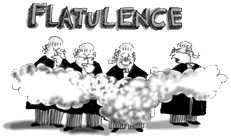Seamless expressions of empathy
 Stephen Keim & Jordan Sosnowski •
Stephen Keim & Jordan Sosnowski •  Tuesday, December 4, 2012
Tuesday, December 4, 2012 The evolution of human rights to animal rights ... Stephen Keim and Jordan Sosnowski trace the movement from Pythagoras to vegetarian monsters to William Wilberforce ... Animal rights and vegetarianism
 What would Pythagoras think?
What would Pythagoras think?
We can imagine the cry of one,
the hunger of two, the burning of ten,
but past a hundred there is no clear imagining.
ALL campaigners, whether they be advocating on behalf of animals or humans, must struggle with this psychological truth.
In his 2010 Blackburn Lecture, Julian Burnside invoked the idea that people care more about animals than their fellow humans.
Burnside was comparing the upsurge of public outrage in response to the treatment of animals exported to the Middle East to the apparent lack of public concern about the treatment of asylum seekers who make it to Australian shores.
The difference in public response may be more apparent than real. More than 500 million animals live and die each year in factory farms in Australia, without noticeable outbursts of concern by the Australian public.
Throughout our history there have been people who have been able to combine the advance of human rights with the promotion of the welfare of animals.
The two causes are not mutually exclusive. We should not be surprised by this. They each flow from the ability to care about the interests of others.
Empathy does not have arbitrary boundaries.
Pythagoras
Pythagoras is best known for his contribution to mathematics and western philosophy. He also practised a Buddhist-like notion of kindness towards animals.
His greatest mathematical discovery was the infamous theorem concerning right-angled triangles. Pythagoras was at home in geometry, which commences with things that are self-evident and leads, by way of deductive reasoning, to conclusions that are not self-evident and not at all obvious.
Pythagoras' methodology is reflected in the famous words of the 1776 Declaration of Independence of the American colonies, one of the foundation human rights instruments: "We hold these truths to be self-evident."
Pythagoras also founded a religion based on the transmigration of souls, making him one of the first western thinkers to advance the idea of reincarnation. His ideas promoted equality between men and women, something that was very progressive for his time.
His views on equality led him to practise an early version of communism.
From the same bundle of ideas came his belief in animal welfare.
Pythagoras did not eat the flesh of animals. Nor did he allow his followers to kill animals in sacrifice.
His concern for the welfare of humans and animals was inter-connected.
"As long as men massacre animals, they will kill each other. Indeed, he who sows the seeds of murder and pain cannot reap joy and love."
Pythagoras was influential in widening the moral compass of future philosophers to include animals among the beings worthy of human empathy.
Mary Wollstonecraft and the Romantics
Mary Wollstonecraft was one of the earliest feminists and famous for championing the women's rights movement.
In an interesting ancillary development, her views led to others close to her advancing the cause of animal rights.
In 1792, Wollstonecraft wrote A Vindication of the Rights of Woman, which advocated sexual equality and a dramatic change in education of women so that women were not simply taught how to be "alluring mistresses", but also "rational mothers".
As with Pythagoras, Wollstonecraft's ideas about the rights of women were way out in front of the rest of society at the time.
Wollstonecraft's daughter, Mary Shelley, gave a new focus to her mother's ideas in Frankenstein.
Wollstonecraft wrote that women ...
"are treated as a kind of subordinate beings, and not as a part of the human species."
Mary Shelley created Dr Frankenstein's Monster. The Monster is cast as an "outsider" but the creature is also a vegetarian.
By gaining sympathy for the "outsider", Mary Shelley utilises her mother's concept of equality to highlight issues common to both women's rights and animal rights.
Mary Shelley's husband, Percy Bysshe Shelley, was also influenced by Wollstonecraft's ideas of equality when he wrote A Vindication of Natural Diet.
He saw abstinence from meat as a social levelling mechanism, a way to bring about a restructure of the classes by foregoing needless luxuries.
Shelley's writing also employs a theme of pacifism towards all beings and his work carries "an explicitly vegetarian message".
Shelley articulated the notion that pacifism and equality extended beyond the human circumstance, to all sentient creatures.
His teachings influenced later writers including George Bernard Shaw and Mahatma Ghandi.
William Wilberforce and his legacy
William Wilberforce is primarily known for his pivotal role in abolishing the slave trade in England. However, he was also one of the founding members of the Society for the Prevention of Cruelty to Animals and a strong supporter of legal rights for animals.
Wilberforce funded hospitals and schools and was a patron of the arts. He also advocated laws to prevent the exploitation of child labour.
Wilberforce's passion for social justice stemmed from a deeply religious base and a commitment to benevolence towards others.
The statute to abolish the slave trade finally came into effect in 1808. When the legislation was passed, Wilberforce reacted by asking, "Well, what shall we abolish next?"
He devoted his energies, alongside MP Richard Martin and other humanitarians, to establish the Society for the Prevention of Cruelty to Animals.
The first goal of the group was to reduce the improper treatment of cattle in the trip to urban slaughter. This was achieved in 1822 with the passage of Martin's Act, the first specific piece of anti-cruelty legislation in the world.
For Wilberforce, the issue was not whether the abolitionist cause was more important than preventing cruelty to animals. Both causes sought to correct injustice.
Conclusion
Philosophically, human and animal rights are not mutually exclusive.
For activists, the constraints of time, energy and resources mean that choices must be made as to the particular field in which to correct injustices.
The enemy of most people who campaign against injustice is a lack of empathy on the part of those whom we seek to persuade and enlist to our cause.
The ability to feel empathy, as the quote from George Steiner at the beginning of the article suggests, can dissipate where injustice involves cruelty to many.
To have a belief in the well-being of animals goes hand in hand with a commitment to human rights.
Stephen Keim SC & Jordan Sosnowski
 Animal rights,
Animal rights,  Human rights,
Human rights,  Julian Burnside
Julian Burnside 









Reader Comments